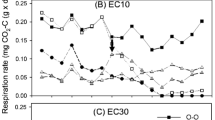Summary
The effects were studied of varying amounts and forms of N fertilizers on the chemical composition of soil solution and on the uptake of N, K, Na, Ca and Mg by barley.
In isolated soil solution the concentrations as well as the ratios of individual cations depended on form and amount of added nitrogen. The concentration of Σcations increased proportionally with applications of nitrate+sulphate. Cation-activity ratios in isolated soil solution were governed by the ratios of corresponding exchangeable cations. During the entire growth period the absorption by the plants of individual as well as of Σcations was independent of their concentrations in soil solution. So long as NH4 ions were present in the soil solution, plants with NH4 addition contained less Σcations than those with NO3 addition. Thereafter the amounts of Σcations in the plant were closely correlated with N absorption, but not affected by form of applied N. The ratios K/(Ca+Mg) and Ca/Mg in the plant were closely correlated with corresponding activity ratios but independent of concentration ratios of these ions in isolated soil solution. It is postulated that uptake of Σcations is governed by N-metabolic processes in the plant, whereas ratios of absorbed cations are influenced by cation-activity ratios in the soil solution.
Similar content being viewed by others
References
Arnold, P. W., Tunney, H., and Hunter, F., Potassium status: soil measurements and crop performance. Trans. 9th Int. Congr. Soil Sci.2 613–620 (1968).
Adams, F., Ionic concentrations and activities in soil solutions. Soil Sci. Soc. Am. Proc.35 420–426 (1971).
Barber, S. A., A diffusion and mass-flow concept of soil nutrient availability. Soil Sci.93 39–49 (1962).
Beckett, P. H. T. and Nafady, M. H. M., The significance of cation activity ratios. Agrochimica13 469–477 (1969).
Bolt, G. H., Cation-exchange equation used in soil science — A review. Neth. J. Agr. Sci.15 81–103 (1967).
Bremner, J. M., Forms of nitrogen in soils and plants. Rep. Rothamsted Exp. Sta.1959 59 (1959).
Bremner, J. M. and Shaw, K., Determination of ammonia and nitrate in soil. J. Agr. Sci.46 320–328 (1955).
Cunningham, R. K., Cation-anion relationships in crop nutrition. I. Factors affecting cations in Italian rye-grass. J. Agr. Sci.63 97–101 (1964).
Cunningham, R. K., Cation-anion relationships in crop nutrition VI. The effects of part, age and species of plant and some soil characteristics. J. Agr. Sci.70 237–244 (1968).
Dijkshoorn, W., A note on the cation-anion relationships in perennial ryegrass, Neth. J. Agr. Sci.5, 81–85 (1957).
Itallie, T. B. van, Cation equlibria in plants in relation to the soil. Soil Sci.46 175–186 (1938).
Kirkby, E. A. and Mengel, K., Ionic balance in different tissues of the tomato plant in relation to nitrate, urea or ammonium nutrition. Plant Physiol.42 6–14 (1967).
Mattson, S., Ionic relationships of soil and plant. III. Positive and negative salt effect. A new look on plant nutrition. Acta Agr. Scand.19 127–134 (1969).
Mengel, K. und Forster, H., Der Einfluss der K-Konzentration der Nährlösung auf die Ertragsbildung, die Qualität und den K-Aufnahmeverlauf bei Hafer. Plant and Soil35 65–75 (1971).
Nemeth, K., Photometrische Sulfatbestimmung in der Bodenlösung. Z. Pflanzenernähr. Düng, Bodenk.103 193–196 (1963).
Nielsen, K. F. and Cunningham, R. K., The effects of soil temperature and form and level of nitrogen on growth and chemical composition of Italian ryegrass. Soil Sci. Soc. Am. Proc.28 213–218 (1964).
Nielsen, N. E., A transport kinetic concept of ion uptake from soil by plants. I. A method for isolating soil solution from soils with or without plant cover. Plant and Soil36 505–520 (1972).
Olsen, C., The significance of concentration for the rate of ion absorption by higher plants in water culture. Phys. Plantarum,3 152–164 (1950).
Salmon, R. C., Cation-activity ratios in equilibrium soil solutions and the availability of magnesium. Soil Sci. 98, 213–221 (1964).
Schofield, R. K., A ratio law governing the equilibrium of cations in the soil solution. Proc. 11th Intern. Congr. Pure Applied Chem., 247–251 (1947).
Wallace, A., Toth, S. J., and Bear, F. E., Further evidence supporting cation-equivalent constancy in alfalfa. J. Am. Soc. Agron.40 80–87 (1948).
Wild, A., Rowell, D. L., and Ogunfowora, M. A., The activity ratio as a measure of the intensity factor in potassium supply to plants. Soil Sci.108 432–439 (1969).
Author information
Authors and Affiliations
Rights and permissions
About this article
Cite this article
Hansen, E.M. Studies on the chemical composition of isolated soil solution and the cation absorption by plants. Plant Soil 37, 589–607 (1972). https://doi.org/10.1007/BF01348517
Received:
Issue Date:
DOI: https://doi.org/10.1007/BF01348517




